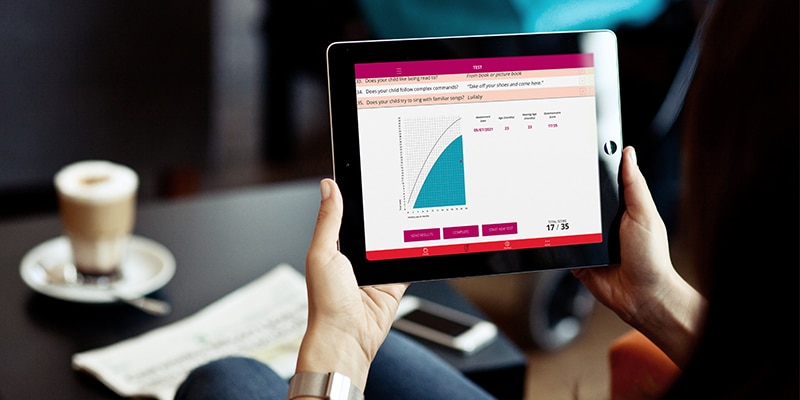MED-EL
Published Nov 21, 2022
LittlEARS® Auditory Questionnaire for Assessment of Babies & Toddlers

The tendency toward early diagnosis and intervention for children with hearing loss requires diagnostic tools to assess and monitor early development. When providing intervention to young children with hearing loss, professionals need to be aware not only of speech and language milestones but also to monitor auditory development.
Auditory skills are the basis for spoken communication. For that reason, monitoring auditory development in the early years is key to ensuring that strong foundations for language learning are built.
The LittlEARS® Auditory Questionnaire (LEAQ) was developed to support professionals and caregivers to monitor the auditory skills of young children with hearing loss. It is based on caregivers’ observation of their child’s auditory behavior in daily life. It includes 35 age-dependent questions to be answered with a yes or no (Figure 1). The questions reflect key milestones of auditory development in the first two years of life or up to two years hearing age (for children with hearing devices).
The LEAQ is one of the few questionnaire-based early auditory assessments with normative data.[1,2,3,4,5] It allows professionals to compare a child’s score against previous scores to monitor progress or compare a score with hearing age or age-matched, typically hearing peers (Figure 2). The questionnaire is suitable for children up to 24 months old, or with a hearing age of 24 months.
How to Access the LittlEARS Auditory Questionnaire

Fig. 1: Example of questionnaire in paper and app formats
The LittlEARS Auditory Questionnaire app is now available for free for tablets on the Apple App Store and the Google Play Store. The app is currently available in English and German.
Alternatively, the LittlEARS Auditory Questionnaire is available in print in more than 40 languages. Contact a MED-EL representative in your area for information on how to purchase a print version of the LittlEARS Auditory Questionnaire.
How to Monitor Auditory Progress With the LittlEARS Auditory Questionnaire

Fig. 2: Example of progress assessment in paper and app formats
The LEAQ is to be completed with the caregiver. It takes approximately 15 minutes to complete. Responses to the questionnaire are tallied and used (with the child’s chronological or hearing age) to chart the child’s progress and compare it to normative data. The child’s total raw score is marked on the graph at the point where the hearing age and the total score intercept.
The graph in Figure 2 shows the normative curve (black curved line), and the below-average range field (blue shaded area). A child’s scores may be marked on the graph over time to monitor progress.
If using the app, scores will be automatically displayed in the graph once the questionnaire is completed. Professionals can monitor progress, save results, and generate summary reports all in the app (all information is stored locally on the user’s device). If a child’s score falls below the average range, further auditory investigations are recommended.
For more information about LittlEARS® Assessment Battery, including the LittlEARS® Early Speech Production Questionnaire, and LittlEARS® My Diary, see the MED-EL Rehabilitation Catalog.
References
- Coninx, F., Weichbold, V., Tsiakpini, L., Autrique, E., Bescond, G., Tamas, L., … & Brachmaier, J. (2009). Validation of the LittlEARS® Auditory Questionnaire in children with normal hearing. International Journal of Pediatric Otorhinolaryngology, 73(12), 1761-1768. https://doi.org/10.1016/j.ijporl.2009.09.036
- May-Mederake, B., Kuehn, H., Vogel, A., Keilmann, A., Bohnert, A., Mueller, S., … & Coninx, F. (2010). Evaluation of auditory development in infants and toddlers who received cochlear implants under the age of 24 months with the LittlEARS® Auditory Questionnaire. International Journal of Pediatric Otorhinolaryngology, 74(10), 1149-1155. https://doi.org/10.1016/j.ijporl.2010.07.003
- Liu, H., Jin, X., Zhou, Y., Jing, L. I., Liu, L., & Xin, N. I. (2015). Assessment and Monitoring of the LittlEARS® Auditory Questionnaire Used for Young Hearing Aid Users in Auditory Speech Development. Journal of Audiology and Speech Pathology, (3), 291-294. https://pesquisa.bvsalud.org/portal/resource/pt/wpr-463155
- Obrycka, A., Lorens, A., García, J. L. P., Piotrowska, A., & Skarzynski, H. (2017). Validation of the LittlEARS Auditory Questionnaire in cochlear implanted infants and toddlers. International Journal of Pediatric Otorhinolaryngology, 93, 107-116. https://doi.org/10.1016/j.ijporl.2016.12.024
- Bagatto, M. P., Brown, C. L., Moodie, S. T., & Scollie, S. D. (2011). External validation of the LittlEARS® Auditory Questionnaire with English-speaking families of Canadian children with normal hearing. International Journal of Pediatric Otorhinolaryngology, 75(6), 815-817. https://doi.org/10.1016/j.ijporl.2011.03.014
MED-EL
Was this article helpful?
Thanks for your feedback.
Sign up for newsletter below for more.
Thanks for your feedback.
Please leave your message below.
CTA Form Success Message
Send us a message
Field is required
John Doe
Field is required
name@mail.com
Field is required
What do you think?
Teresa Cunningham
September 27, 2023
Hello, I cannot find the app on my IPad. How do I get the questionnaire?
MED-EL
September 28, 2023
Hi Teresa, thanks for reaching out. If you're experiencing issues with finding the app, we recommend reaching out to your local MED-EL team via https://www.medel.com/clinic-finder. Kind regards, Gordana
Monika
March 27, 2024
Hello, we want to use the questionnaire for our research on the new application supporting speech therapy for children. I tried to contact a local clinic (from your site), unfortunately without success, nobody is returning calls/text messages. Please provide a contact for someone in Poland where we can purchase the forms. Thank you
MED-EL
March 28, 2024
Hi Monika, thank you for reaching out. Please check out this link to get in touch with your local experts: https://www.medel.pro/contact-med-el Kind regards, Gordana
Natalia Povedano Valverde
April 14, 2024
Hola! Soy fisioterapeuta especializada en desarrollo y me interesa mucho el cuestionario littlears, sería posible tenerlo en español? Gracias!
MED-EL
April 15, 2024
Hi Natalia, thank you for your comment. Please find our rehab download materials in Spanish here: https://www.medel.com/es-es/support/rehabilitation/rehabilitation-downloads Please let us know if you need any further assistance. Kind regards, Gordana
Roaa Nasir
February 13, 2025
We need the Arabic version of LittlEARS® Auditory questionnaire for research in Sudan, which is a third-world country in Africa, currently facing a war. We are unable to purchase it. Can we get it for free due to our special situation?
MED-EL
February 17, 2025
Hi Roaa, thank you for your comment. You can filter by Arabic language here: https://www.medel.com/support/rehabilitation/rehabilitation-downloads-for-children, and download the files you need. If what you're looking for is not available in your language, please reach out to your local MED-EL team to request it. You can do so here: https://www.medel.com/ar/contact-med-el. Kind Regards
Emmanuel Leonard
April 24, 2025
Dear I am slp and Audiologist from Tanzania. Kindly help me the email of any Med-El person l can contact for my concerns
April 25, 2025
Hi Emmanuel, thanks for reaching out to us. Please send us your request and contact details via our website https://www.medel.pro/contact-us. Kind regards, Barbara
MED-EL




Conversation
5 Comments